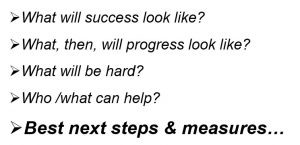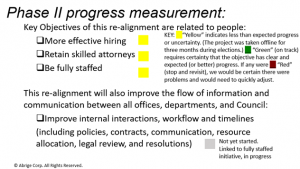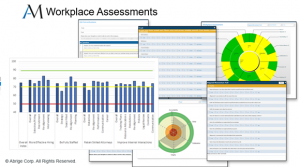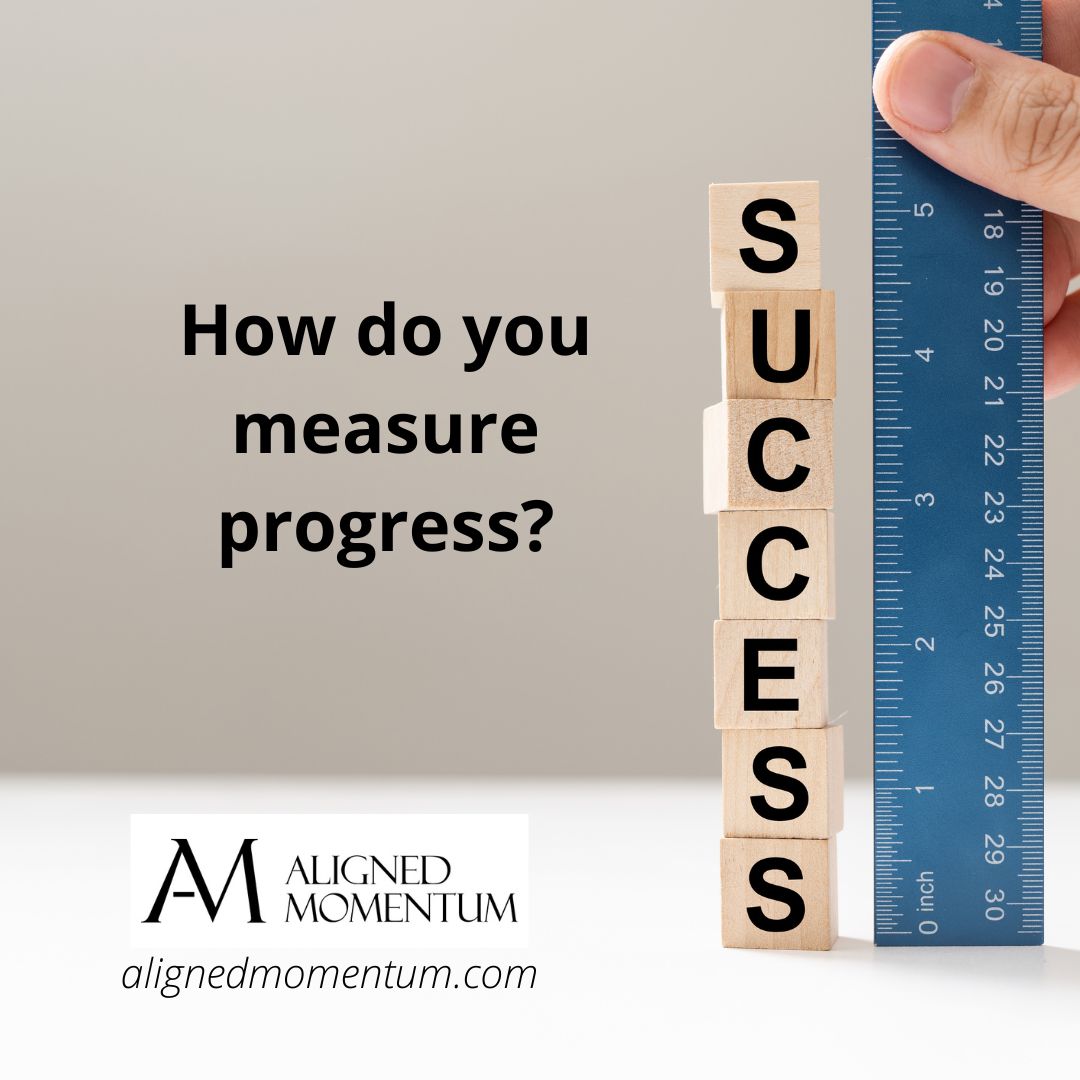You’ve set your objective (Part I), defined what success and progress will look like (Part II), identified what will be hard (Part III), and brainstormed who and what can help minimize that hard stuff (Part IV).
Now it is time to define measurements, so you (and all) can know that the progress and success desired are on track, consider your best next action steps and then ask those who are part of this journey to choose the actions—the best next steps—they will take.

The example I started in Part I shared what success looked like for a client moving through a re-alignment to the organization’s mission and vision. Each part carried forward this same example through these steps.
Progress measurement – a sample progress summary
Here’s another look at the four key objectives and a summary of progress six months into the re-alignment:

Use assessments for qualitative progress measures
Because the four key objectives were about people, the best way to measure progress was through assessments, displayed with reports like these:

The detail is hard to see, so I’ll explain a bit about:
- What types of assessments were given,
- How the assessments are customized to fit each client,
- How we determined “who” would take the assessments,
- Frequency,
- Collection methods, and
- How the data was used to determine if progress was being made (and also to see if the assessments were properly identifying success, or if they needed to be altered for more meaningful data.
What types of assessment were given?
Let’s start with the types of assessments we selected from for this client.
reviews, assessments, conversations
- A 360 REVIEW is performed proactively for development of an individual.
- A 1-1 REVIEW (OR EVALUATION) is focused on past performance.
- 1-1 FUTURE LOOK/GOAL-SETTING is open conversation about the expected individual growth this year in their role. Priorities conversations fit here.
- AN HR/ORG CULTURAL ASSESSMENT is for understanding the health of the org or teams within it.
- A PEER ASSESSMENT is best for gaining insight into individual effectiveness and living core values at work.
In this case, all were recommended at points during this two-year initiative. During the first nine months we focused on #4, HR/Org Culture Assessment.
How were the assessments customized?
These assessments were built to ask questions that would bring out the most complete and honest answers. The questions were categorized in order to deliver reports with the most actionable information possible, without exposing the identities of who responded and how they answered or commented on each question.
How we determined “who”
It was important to create assessments for the legal team, as well as key people in other departments who relied on the support of the legal team (such as HR), and the Council (Board) members who were being pulled in to manage disruption caused by the current misalignment of this team.
Frequency
Frequency was quarterly. Unless an initiative is to be completed in under a quarter, quarterly is the timing we recommend.
Collection methods
Different people and groups may require different means of collecting the assessment results. Some will be ready to simply complete an online form with a few notes explaining the assessment form.
At first, plan to provide in-person explanation about why the assessment is being given, what it entails, what you need from each person, what you intend to draw from the assessments, how their identities will be protected (or not, depending on how you choose to assess), and what they can expect after completing the assessment.
We employed a mix of 1-1 meetings live or via phone or zoom, and group meetings where the assessment was taken during that meeting. We recommend that any assessments take under 25 minutes to complete. Many assessments, if no comments are collected, may take 5 minutes or less.
How will *you* use your assessment results?
Know how you intend to use, and take action on, assessments before you ask any individual to take it. This is so important. Collecting data just to collect it, is not only ineffective; it can create fear and disengagement.
It is human nature to assume that nothing good is being done if a purpose is not clear.
It is also human nature to expect to see some results or feedback from an action they are asked to take. This can be in the form of a thank you, followed by an action that is associated with the aggregated assessment results or a statement of why no action is being taken at this time (such as waiting to see next quarter for the trend).
You can do this in your organization. If you are committed to transformation, the process shared in Parts 1-V has worked well for many. Here’s an except from the leader of this case study:
“…She led us through a process to ensure alignment of objectives with our vision and strategy, helped us create and give assessments that would provide us with meaningful feedback on progress and the effect of the changes on others, which included many other departments, offices and Council. We received meaningful and actionable feedback from the assessments, given over time, and from her time with the team. Within just nine months those four key objectives were achieved.”
Want results like this? Learn more about the Aligned Momentum Program.
Your best next step
For your best next step toward achieving key objectives, identify how you will measure progress.

